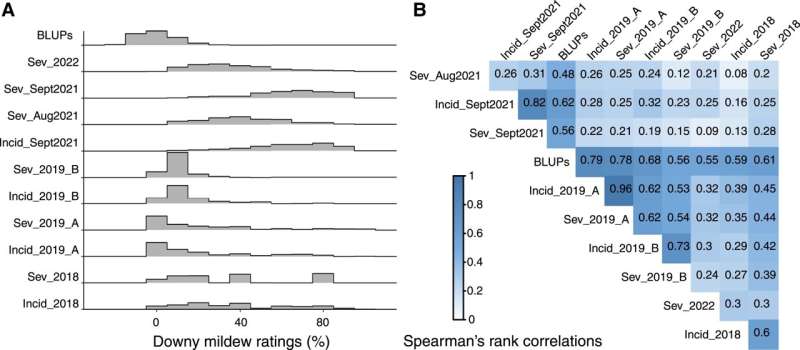This article has been reviewed according to Science X's editorial process and policies. Editors have highlighted the following attributes while ensuring the content's credibility:
fact-checked
trusted source
proofread
Gene discovery may help growers battle grape downy mildew

Researchers at Cornell have discovered a new grape downy mildew resistance gene—giving the wine and grape industry a powerful new tool to combat this devastating disease.
"Of the downy mildew resistance genes found in the world to date, this is one of the strongest," said Lance Cadle-Davidson, adjunct professor in the School of Integrative Plant Science in the College of Agriculture and Life Sciences, and a research plant pathologist with the USDA's Grape Genetics Research Unit in Geneva. "The discovery could help breeders develop more resistant grape varieties."
Caused by the fungus Plasmopara viticola, grape downy mildew (GDM) is one of the most damaging grape diseases in the Eastern United States. Grape clusters are highly susceptible after the vines finish blooming, and late-season infections can defoliate vines right when the berries are trying to ripen. This damages maturation, winter hardiness and eventually crop return.
The research discovery is outlined in the paper, "A Multitiered Haplotype Strategy to Enhance Phased Assembly and Fine Mapping of a Disease Resistance Locus," which published in Plant Physiology.
The lead authors were Cheng Zou, research associate at Cornell's Bioinformatics Facility, Qi Sun, co-director of the Facility, Surya Sapkota, a former postdoctoral researcher and now grape breeder at the USDA and Cadle-Davidson.
The gene was discovered in a grapevine accession known as Vitis x doaniana, a naturally occurring hybrid of two wild grapevines, now maintained in the USDA-ARS grape germplasm repository located at Cornell AgriTech.
Cadle-Davidson noticed that the accession seemed to be resistant to downy mildew in the field and turned to the Bioinformatics Facility for further investigation.
Using a three-step process developed through VitisGen2, a multidisciplinary project focused on decreasing the time, effort and cost involved in developing the next generation of grapes, the facility was able to find the gene responsible in just two months.
Using low-resolution genetic mapping in a large breeding population, the team narrowed possible gene candidates down to a few hundred genes. Next, high-resolution mapping of the recombinants further narrowed down the gene candidates to a couple dozen. Finally, using phased assembly of the chromosomes of the Vitis x doaniana parent and comparative analysis of the resistant and susceptible alleles, the exact genetic basis of downy mildew resistance was identified.
"One of the most groundbreaking components of this research is the strategy that was used because it could be a gamechanger for specialty crop breeders everywhere," Sun said. "Breeders could use this process to quickly and efficiently identify genes in other heterozygous crops such as apples."
When it comes to the development of new grape varieties, the newly discovered gene could help growers battle GDM long term as climate change leads to upticks in GDM epidemics across the Northeast.
"Growers commonly use fungicides to control GDM, but GDM can eventually build up resistance to fungicides," said Bruce Reisch, grape breeder and professor emeritus of horticulture in CALS. "Developing new grape varieties for growers with a variety of strong resistant genes is the ultimate solution."
A typical vinifera vineyard in the Northeast may require upwards of 12 sprays of fungicides for downy mildew, powdery mildew and other diseases.
"If a grower were to produce grapes that had resistance to these diseases, the number of sprays in a vineyard could potentially go down to one to two per year," said Reisch. "With the tools we have now, there are endless possibilities to develop new grapes that deliver on both quality and disease resistance."
More information: Cheng Zou et al, A multitiered haplotype strategy to enhance phased assembly and fine mapping of a disease resistance locus, Plant Physiology (2023). DOI: 10.1093/plphys/kiad494
Provided by Cornell University





















